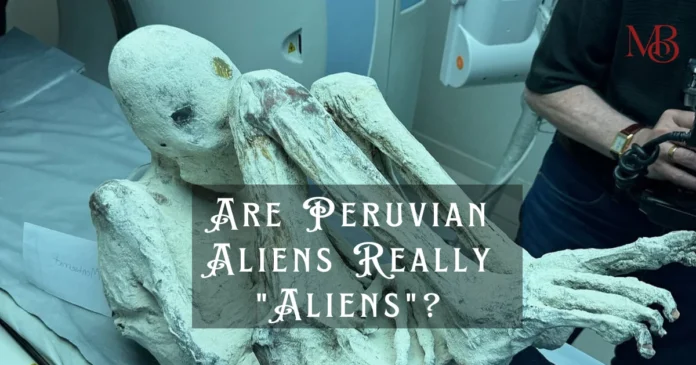Peruvian Aliens: High in the Andes Mountains, shrouded in mist and mystery, lies the ancient city of Machu Picchu. But beyond the architectural marvels and historical whispers, a peculiar legend lurks tales of elongated skulls, extraterrestrial visitors, and a challenge to our understanding of humanity’s past. Buckle up, because we’re diving into the fascinating, and often controversial, world of the “Peruvian aliens.”
Peruvian Aliens: Breaking Down the Bony Bafflement
The alleged “alien” skulls come in various shapes and sizes, some boasting elongated domes, prominent brow ridges, and oddly positioned eye sockets. These features, far from the familiar human cranium, fueled speculation about otherworldly origins. However, science refuses to be seduced by sensationalism.
Anthropological and forensic examinations revealed these skulls fall within the spectrum of human anatomical variation, particularly those of indigenous Andean populations. Cranial deformation practices, common in the region, likely played a role in shaping these skulls. Pressure applied during infancy could reshape the growing bone, resulting in an elongated appearance.
Furthermore, radiocarbon dating places the skulls firmly within the timeline of known human presence in the area, shattering claims of extraterrestrial visitors from distant galaxies. DNA analysis, where possible, adds another layer of debunking, confirming the skulls belong to human lineages native to the Americas.
Peruvian Aliens: Alternative Explanations and Enduring Enigmas
While the “alien” hypothesis loses traction under scientific scrutiny, alternative explanations abound. Medical conditions like craniosynostosis, where skull bones fuse prematurely, can also mimic the unusual features. Additionally, environmental factors and dietary deficiencies might have influenced skull development in past populations.
However, not all mysteries are neatly tucked away. The exact methods used for cranial deformation remain an area of active research. Moreover, the cultural and symbolic significance behind these practices continues to intrigue anthropologists and archaeologists. Did they signify social status, religious beliefs, or something entirely different? The whispers of the past carried on the wind through the Andes, await further deciphering.
Peruvian Aliens: Fact Versus Fiction in the Shadow of the Sun God
Machu Picchu, often intertwined with the “alien” skull narrative, deserves its own spotlight. This breathtaking Inca city, nestled amidst cloud-kissed mountains, is a testament to human ingenuity and architectural prowess. Its sophisticated water systems, advanced agricultural techniques, and astronomical alignments speak volumes about the advanced civilization that called it home.
Attributing extraterrestrial intervention to Machu Picchu’s construction diminishes the remarkable achievements of the Inca people. Their mastery of stonework, engineering, and adaptation to a challenging environment deserves recognition without resorting to fantastical explanations.
Peruvian Aliens: Skepticism, Curiosity, and the Quest for Knowledge
The story of the “Peruvian aliens” serves as a cautionary tale against readily accepting sensational claims. Approaching extraordinary stories with a critical eye and seeking scientific evidence is crucial in navigating the ever-shifting knowledge landscape. However, healthy skepticism shouldn’t stifle curiosity.
The “alien” skulls, despite their earthly origins, hold immense value for understanding past cultures, medical practices, and human diversity. They urge us to delve deeper, to ask questions, and to appreciate the complexities of our shared history.
So, the next time you encounter tales of otherworldly visitors and enigmatic skulls, remember: the truth, while sometimes less exotic, is often far more captivating. Open your mind to the wonders of human resilience, ingenuity, and the enduring mysteries that continue to whisper from the shadows of time.
The “Peruvian aliens” may not be from distant galaxies, but their story is far from over. It’s a tale of scientific inquiry, cultural understanding, and the enduring human quest to unravel the mysteries of our past. As we continue to explore, research, and learn, the true picture behind these fascinating skulls will undoubtedly come into sharper focus. And who knows, perhaps the whispers of the Andes hold yet more secrets waiting to be unearthed.
Peruvian Aliens: Archaeological Adventures and Ancient Practices
Our journey begins with the excavation of these peculiar skulls. In the early 1930s, American explorer Hiram Bingham, while exploring the ruins of Paracas, stumbled upon a cache of elongated skulls. This discovery, along with others in the subsequent decades, sparked widespread intrigue and ignited the “alien” hypothesis.
However, archaeological investigations soon revealed a more grounded reality. These skulls were found alongside artifacts and burial goods associated with the Paracas and Nazca cultures, thriving civilizations that predated the Incas in the region. This association pointed towards an explanation far less fantastical than extraterrestrial visitors.
Peruvian Aliens: Cultural Significance and Enduring Questions
The elongated skulls, it turned out, were the result of a deliberate cultural practice known as cranial deformation. This practice involved applying pressure to an infant’s skull using various methods, such as bandages, padding, or even boards. The exact reasons behind this practice remain debated, but some theories suggest it signified social status, religious beliefs, or even group affiliation.
The Paracas and Nazca cultures, renowned for their intricate textile work and geoglyphs, likely viewed head shaping as a form of body modification, similar to piercings or tattoos in other cultures. While the practice might seem strange to modern eyes, it’s crucial to understand it within the context of these ancient societies and their belief systems.
Peruvian Aliens: Science Steps In the Enigma with DNA and Radiocarbon Dating
But amidst the cultural context, scientific analysis played a crucial role in debunking the “alien” claims. DNA testing, conducted on some of the skulls, revealed a genetic match to indigenous populations of the Americas, further solidifying their earthly origins. Radiocarbon dating placed the skulls within the timeframe of the Paracas and Nazca cultures, firmly grounding them in human history.
These scientific advancements provided concrete evidence against the extraterrestrial hypothesis. While the elongated skulls might have sparked imaginations, the truth lay not in distant galaxies but in these ancient civilizations’ cultural practices and ingenuity.
Peruvian Aliens: Beyond the Skulls
The “Peruvian aliens” story, however, is far from over. While the skulls’ origins have been established, several questions remain unanswered. The exact methods used for cranial deformation, the cultural nuances behind the practice, and its symbolic significance continue to intrigue researchers.
Furthermore, the Paracas and Nazca cultures themselves remain shrouded in mystery. Their advanced knowledge of astronomy, engineering, and textile work hint at a sophisticated society with much to reveal. Unraveling these mysteries promises to shed light not only on these specific cultures but also on the broader understanding of human development and cultural diversity in the Americas.
Peruvian Aliens: A Tapestry of Knowledge, Woven from Skulls and Stories
The “Peruvian aliens” phenomenon, despite its fantastical leanings, serves as a valuable reminder of the importance of critical thinking and scientific inquiry. It’s a story that compels us to move beyond sensational claims and delve deeper into the cultural and historical contexts that shape our understanding of the past.
As we continue to explore the ancient Andes, piece by piece, the legacy of the Paracas and Nazca cultures comes into sharper focus. Their skulls, once shrouded in mystery, now serve as portals to a fascinating chapter in human history. And who knows, perhaps future discoveries will shed even more light on these enigmatic civilizations and the enduring questions they continue to pose.
You might also like: Alien Abduction: Fact or Fiction?
Remember, this is just a starting point. Feel free to add your own insights, personal experiences, or further research findings to personalize the blog and make it truly yours. Let’s continue the conversation and deeper into the captivating world of the “Peruvian aliens.” Follow our newscast page for more.


